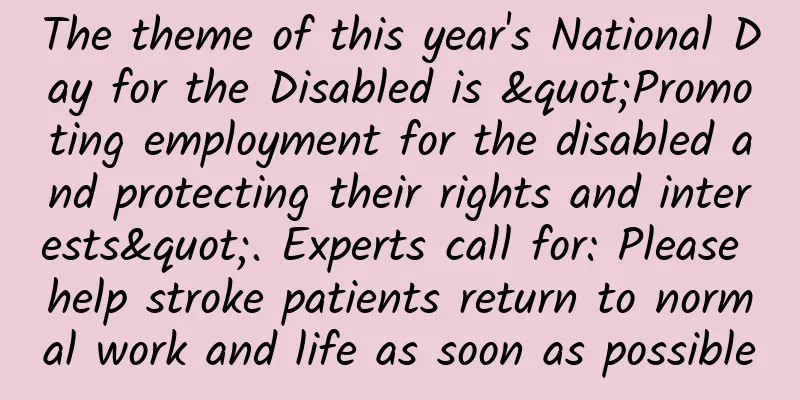The theme of this year's National Day for the Disabled is "Promoting employment for the disabled and protecting their rights and interests". Experts call for: Please help stroke patients return to normal work and life as soon as possible

|
Brother Liu, who is nearly 60 years old, is usually very strong and has no problems. One morning, his daughter, who is a nurse in the internal medicine department, suddenly found that her father's face was stiff and dull, his mouth was crooked, his speech was unclear, and one side of his limbs was out of control. She and her family immediately sent him to a local specialist hospital. After a medical examination by experts and an emergency CT scan, it was confirmed that Brother Liu suffered from "acute ischemic cerebrovascular disease". After intravenous drug thrombolysis, the severely blocked left middle cerebral artery was successfully cleared for him; after the condition stabilized, the patient was immediately transferred to the Rehabilitation Medicine Department of Heilongjiang Provincial Second Hospital. The director of the department, Professor Fan Yongchun, led the team to quickly carry out follow-up rehabilitation intervention for him. Now Brother Liu has recovered well, and his limb strength is almost the same as that of a normal person, avoiding the common sequelae of stroke such as "carrying a basket", "swinging legs", and "crutches". The biggest physical disability comes from stroke. According to Article 14 of the Law of the People's Republic of China on the Protection of Disabled Persons, the third Sunday of May each year is the National Day for the Disabled. The theme of this year's 32nd National Day for the Disabled is "Promoting employment for disabled persons and protecting their rights and interests". In an interview with the media, Professor Fan Yongchun, a member of the Standing Committee of the Trauma Rehabilitation Committee of the Chinese Rehabilitation Medicine Association, a national outstanding rehabilitation physician, and director of the Rehabilitation Medicine Department of the Second Hospital of Heilongjiang Province, introduced that according to the latest statistics from the China Disabled Persons' Federation, there are currently 85 million disabled people in my country, accounting for about 6.21% of the total population. The survival difficulties caused by disability and even the loss of self-care ability have brought great pain and long-term economic burden to the patients, their families and the society. Among them, as an acute cerebrovascular disease with severe disability and severe impact, stroke is also called cerebral infarction or cerebrovascular accident. It is caused by the sudden rupture or blockage of blood vessels in the brain, which prevents blood from flowing into the brain, and eventually leads to a group of brain tissue damage diseases, including ischemic stroke and hemorrhagic stroke. The incidence of the former accounts for 60-70% of the total number of strokes. Professor Fan introduced that the latest statistics released by the National Health Commission show that the number of stroke cases in my country is about 1.5 million to 2 million each year, and the total number of stroke patients has exceeded 28 million. Among them, 70-80% of stroke patients have left hemiplegia, aphasia, cognitive dysfunction, etc., and even have to rely on wheelchairs or stay in bed for a long time due to severe disabilities. At present, stroke in both urban and rural areas has become the leading cause of death and disability among adults in my country, with the characteristics of "five highs", including high morbidity, high disability rate, high mortality rate, high recurrence rate, and high economic burden. Professor Fan Yongchun pointed out that evidence-based medicine has confirmed that rehabilitation medicine is one of the most effective means to reduce and alleviate the disability rate of stroke, and is an indispensable key link in the organized management model of stroke. In order to cultivate the trend of helping the disabled in the whole society and enhance the awareness of helping the disabled, it is necessary to approach stroke patients and understand the risk factors of stroke, self-identification of stroke, three-level prevention of stroke, and rehabilitation of stroke, so as to prevent it and stay away from the sneak attack of stroke. Facing the threat of stroke, we are not helpless. Director Fan explained that from a clinical point of view, stroke risk factors are usually divided into two categories: non-interventional and interventional. The former mainly include age, race, genetic factors, etc., which cannot be reversed by human means; the latter includes hypertension, diabetes, dyslipidemia, heart disease, alcohol intake, smoking, diet, overweight or obesity, lack of physical activity, psychological factors and many other interventional factors, among which hypertension ranks first, with a relative risk of 2.64. Through human intervention, it is helpful to "brake" the process of stroke. Fan Yongchun introduced that worldwide, 90.7% of strokes are closely related to the above-mentioned interventional risk factors; for the Chinese patient population, the above risk factors are inseparable from 94.3% of strokes. This shows that people are not helpless in the face of the threat of stroke. If they can build "fortifications" early, they can suppress the "rebels" above. So, what does the "three-level prevention of stroke" that doctors often talk about mean? Fan Yongchun explained that primary prevention refers to the identification of high-risk factors before the disease develops, including high blood pressure, high blood lipids and improper lifestyles, and then quickly launching prevention and control to prevent high-risk groups from getting sick; secondary prevention is to take countermeasures immediately after the acute onset of stroke to reduce the risk of recurrence or reduce the degree of disability; tertiary prevention mainly refers to rehabilitation training to restore or compensate for the defective functions as much as possible, so that patients can return to their families and society as soon as possible and improve their daily living ability and level. Pay attention to clues and seek medical treatment in time. Director Fan Yongchun reminds that when the following abnormal situations occur suddenly, you need to see a doctor immediately: First, severe dizziness accompanied by vomiting, such dizziness has nothing to do with changes in body position; second, weakness and numbness of one limb, or numbness of one side of the face, crooked corner of the mouth and drooling; third, slurred speech or aphasia, eyes staring to one side; fourth, choking, coughing, difficulty eating or drinking; fifth, severe and frequent headaches that continue to persist and cannot be relieved; sixth, convulsions, worsening impaired consciousness or trance. At the same time, the FAST stroke prediction principle also has a certain judgment function, and family members are requested to understand and master it. Director Fan explained that F stands for face: ask the patient to smile and observe whether one side of the facial expression is stiff, or whether the eyelids and mouth corners are drooping; A stands for arm: ask the patient to raise the upper limb and observe whether one side of the arm is weak and drooping; S stands for speech: identify whether the pronunciation is clear and the sentence is accurate; T stands for time: when any of the above three situations occurs, you need to seek medical attention immediately, accurately record the time of the onset, and inform the doctor, nurse or emergency personnel who receive the consultation. As for stroke rehabilitation, there is a "golden period" that must not be missed. Professor Fan Yongchun solemnly reminded that the best period for limb function recovery is within six months after suffering a stroke, and the first three months are particularly important. Therefore, rehabilitation therapy must be implemented as early as possible, within one week after the condition stabilizes. Early, regular and comprehensive rehabilitation intervention can not only correct hemiplegia, aphasia, articulation, swallowing, cognitive disorders, etc. to the greatest extent, but also effectively restore the patient's daily living ability and reduce the heavy economic burden on the family and society. Director Fan Yongchun introduced: The rehabilitation process of stroke is completed by the joint efforts of a professional team. Members include rehabilitation doctors, physical therapists, occupational therapists, speech therapists, rehabilitation engineers, psychotherapists, acupuncturists, masseurs, rehabilitation nurses, etc., none of which can be missing; and the rehabilitation process runs through the entire cycle of disease recovery, which not only relies on the help and care of the rehabilitation team, but also requires the cooperation of the patient himself and his family to achieve, ultimately promoting the greatest physical and mental improvement in stroke patients. Rehabilitation medicine helps people return to normal life. At present, what are the main contents of rehabilitation medicine? Professor Fan briefly summarizes it as follows: The first is exercise therapy: it is used to restore motor function after hemiplegia, mainly combining neurodevelopmental techniques with equipment training; the second is occupational therapy: to help patients rehabilitate upper limb motor function, coordination and fine hand movements, aiming to gradually restore daily living activities; the third is physical therapy: with the help of functional electrical stimulation, biofeedback, air pressure waves, wax therapy, hot and cold therapy, hydrotherapy, light therapy, ultrasound, ultrashort wave, microwave, transcranial magnetic stimulation and other technologies and equipment, it is used to prevent various complications and correct existing problems such as muscles and circulation of hemiplegic limbs; the fourth is speech therapy: to restore the patient's lost language communication ability. At the same time, there is also the treatment of swallowing disorders: that is, through low-frequency electrical stimulation, balloon dilatation, oral function control training, swallowing technique training, swallowing reflex and swallowing coordination training, food selection and modulation, and eating guidance, the swallowing function of patients is improved; psychological treatment: patients with hemiplegia due to stroke are often accompanied by depression and anxiety, and need to be given appropriate psychological guidance and mediation to actively and positively conduct rehabilitation training. In addition, rehabilitation engineering and rehabilitation nursing should also be carried out simultaneously. The former is to use orthopedic braces such as foot supports and finger plates to prevent limb deformities and assist functional activities in hemiplegic patients; the latter is to place the functional position of the limbs and carry out passive activities in the early stage of the disease or bedridden period of the patient to prevent respiratory or urinary tract infections, pressure sores and bedsores, and gastrointestinal complications such as indigestion, constipation, hiccups, etc. The above measures must be based on scientific, standardized, and timely rehabilitation evaluations to achieve individualized rehabilitation treatment plans and improve rehabilitation effects. Finally, Professor Fan Yongchun suggested that during the rehabilitation process of stroke patients, they can also choose some appropriate and moderate exercise therapy according to their specific conditions and conditions, such as self-stretching training, self-strength training, specific movements required by rehabilitation physicians, and doing Ba Duan Jin and Tai Chi, etc., to regulate emotions, coordinate internal organs, and promote the recovery of limb functions. However, the rehabilitation of stroke patients must be scientific, reasonable, and gradual. Director Fan suggested that patients and their families should choose professional institutions and professionals to provide rehabilitation and guidance. Director Fan Yongchun Director of the Rehabilitation Medicine Department of Heilongjiang Provincial Second Hospital, Chief Physician, National Outstanding Rehabilitation Physician, and the First Provincial "Longjiang Famous Doctor" in Heilongjiang Province |
Recommend
How long does it take for cervical erosion to go from first to third degree?
Cervical erosion is a common gynecological diseas...
What medicine can pregnant women take for cough
Women must avoid getting sick during pregnancy, b...
Is heavy menstrual flow good or bad?
The amount of menstrual flow varies from person t...
What are the items in routine gynecological examination?
Gynecological diseases are unique diseases that o...
Treating uterine fibroids with turtle shell and angelica
Among gynecological diseases, uterine fibroids ar...
Do kidney stones affect fertility in women?
Pregnancy is a unique function of women. Only whe...
Is orbital inflammatory pseudotumor a tumor? How is it treated?
Author: Xie Like, Chief Physician, Eye Hospital, ...
What seasonings are needed for barbecue? What are the barbecue tips for beginners?
Barbecue is popular with most people. The cultura...
Why do chinchillas bite their own fur? Is there any way to save a chinchilla that bites its own fur?
Chinchillas are very cute and furry. Some owners ...
What should I do if I have extreme pain on the first day of my period?
Because every woman's physical fitness is dif...
Postmenopausal back pain
Menstruation is a trouble that all women have, bu...
How to make pig's trotter soup for pregnant women
Drinking pig's trotter soup is a very good ch...
Two months pregnant blood like menstruation
Due to different physical conditions, pregnant wo...
People who snore when sleeping, beware of 8 major hazards! Huaxi experts: Don't believe in drug treatment, what really works is...
Many people have had this experience. Sleeping wi...
What is ovulation before menstruation?
Many women who want to get pregnant will calculat...









